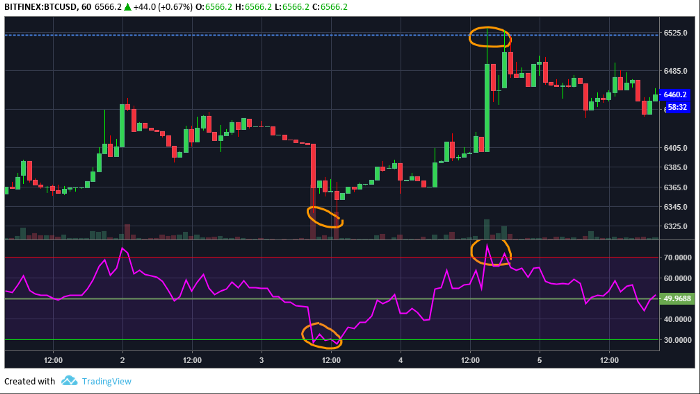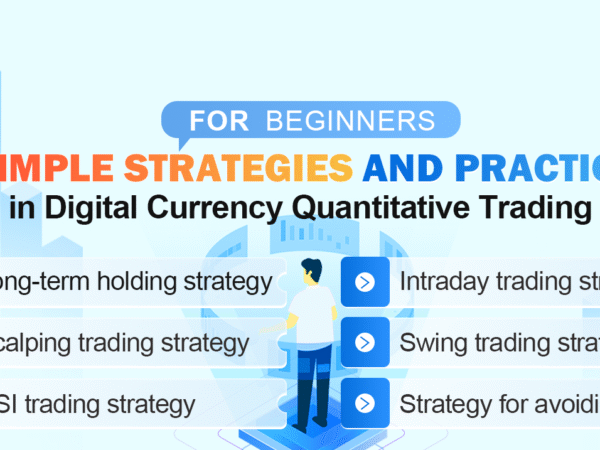Saying that “trading digital currency may be profitable” can be regarded as an understatement. Because many digital currencies have experienced several improvements year on year, they outperform many other asset classes in terms of return on investment (ROI).
However, it may be difficult to select and choose the right trading opportunities and trading strategies – especially when numerous indicators often conflict with each other and make technical analysis confusing sometimes.
Before starting to trade digital currencies and entering the world of overly complex indicators and advanced technical analysis (TA), it is wise to learn some more basic trading strategies first.
This article will discuss some of the simplest strategies for beginners to start trading digital currencies to help them take the first step – using market sentiment, trading volume, price volatility, basic indicators and chart patterns to identify trading opportunities.
Before starting digital currency trading, it is important to step back and consider the amount you are willing to risk investing carefully. Remember that the digital currency market is ruthless. Although this may indeed bring huge benefits, it may also lead to painful losses – so it is recommended to act cautiously.
Even with the best trading strategy, everyone will lose something eventually. The key is to win more often or with more quality than you lose, and avoid some common mistakes that beginners often become victims.
Simple trading strategies for beginners
- Long-term holding (HODL method) strategy
- Intraday trading strategy
- Scalping trading strategy
- Swing trading strategy
- RSI trading strategy
- Strategy for avoiding “the trading target of large funds bookmaking” (mostly fraud) If you can’t bear a little loss, you will take all the losses sooner or later.- Ed Seykota
Long-term holding (HODL method) strategy
So far, the simplest strategy in the above list is long-term holding strategy, also known as simple holding or “hodling” – a common intentional misspelling in the digital currency community.
Holding is very simple (and the most difficult), because it usually requires little knowledge to succeed – because almost all mainstream digital currencies will experience significant long-term growth.
The rule is simple: just buy a digital currency that you think is promising in the future and hold it for several months or years. For example, you can use fiat currency to purchase Bitcoin from mainstream exchanges and check its price after five years.
Unlike other strategies, it is absolutely not necessary to check the price regularly. In fact, this situation should be avoided to prevent you from falling into the situation of early selling due to short-term price fluctuations. On the contrary, the price should only be checked after an extended period of time – if you have reached the profit you seek, you can sell.
Holding is certainly not the most effective strategy in this list, and there is no guarantee that digital currency will continue to develop into the future. In addition, the price at which you buy most of the time is not always the best, because digital currencies usually see sharp price fluctuations in a short time.
Therefore, the long-term holding strategy can be improved to a certain extent by using the “cost averaging” approach (that is, a fixed amount of regular plan to purchase specific investments). For example, if you buy 1 BTC at the price of $7,000, then buy another BTC at the price of $6,400 in a few days, and the average cost of each BTC is $6,700 now.
Cost averaging is designed to protect you from a major price collapse shortly after your investment by averaging your purchase price. This can provide some protection against major market fluctuations and is particularly useful in declining markets.
In any case, when we expect to invest in a currency, especially as a beginner, we suggest carrying out some basic analysis first. This means checking whether the currency really has the reason for growth – including checking its competitors, community interests and team capabilities.
Tips: When it comes to long-term holding, sometimes ignorance is bliss. For a long time, most powerful digital currencies will experience significant price fluctuations. Avoid checking prices regularly, as this may lead you to withdraw from the profitable market prematurely.
On the FMZ Quant platform, the above strategy is realized through quantitative trading, which couldn’t be better. You don’t even need to pay attention to the price itself. The written program will help you place orders and trade automatically under the transaction logic you want.
The following are some classic fixed investment strategy frameworks that readers can improve or expand according to their own needs.
Daily market price fixed investment strategy
function main() {
Log(exchange.GetAccount());
//Date of last investment
var lastInvestDate = '';
while (true) {
//Each loop with an interval of 60 seconds
Sleep(60 * 1000);
//If the current date is the same as the latest investment date, it means that the investment has been made on the current day. Skip.
var now = new Date();
var date = now.toISOString().slice(0,10);
if (date == lastInvestDate) {
continue;
}
lastInvestDate = date;
Log("date: " + date);
exchange.Buy(-1, singleInvestAmount);
}
}
For more information, please refer to: https://www.fmz.com/strategy/151259.
The above strategy was written in Javascript language on the FMZ Quant platform.
There is also a fixed investment strategy for Python:
def onTick():
exchange_count = len(exchanges)
for i in range(exchange_count):
account = exchanges[i].GetAccount()
marketName = exchanges[i].GetName()
depth = exchanges[i].GetDepth()
Log("Market ",marketName,exchanges[i].GetCurrency(),"Account Balance [",account["Balance"],"] Stocks[",account["Stocks"],"]")
if account and depth and account["Balance"] > accountLimitMoney :
bidPrice = depth["Asks"][0]["Price"]
if bidPrice < maxBidPrice :
amount = orderAmount
if amount <= account["Balance"]:
exchanges[i].Buy(amount)
else:
Log("Account Balance is less than bid Amount")
else:
Log("Bid Price >= maxBidPrice, not process")
else:
Log("Account Balance <= accountLimitMoney")
def main() :
while 1:
onTick()
time.sleep(orderTimeInterval)
For more information, please refer to: https://www.fmz.com/strategy/54256.
Intraday trading strategy
Intraday trading is basically the opposite of long-term holding. It is defined as the act of buying and selling the subject matter of the transaction in the same day, usually even multiple times in a day, using small price fluctuations to make profits.
Due to the huge volatility inherent in the price of digital currency, intraday trading can generate huge profits. However, intraday trading is certainly more risky than long-term holding, because if you try to trade currencies that are about to collapse, it is easy to lose most of your profits. Therefore, in intraday trading, it is important to use only the amount you can afford and set appropriate stop loss in the process to prevent any serious loss.
In the field of digital currency, the price of any currency changes rapidly. Due to the micro and macro changes in supply and demand, many digital currencies may have normal price fluctuations of up to 5% in one day. Remember to stay calm and stick to the plan. As long as you win more trades than you lose and your stop loss is always fixed, you will eventually make profits.
Because the market moves so fast, it is very likely that only two or three transactions a day can make good profits. In addition, be careful, because intraday trading will consume a day faster than you think. Once your small trading volume starts to make steady profits, you can increase your trading volume gradually.
You can use a lot of useful technical indicators to find good entry points, including EMA, RSI and MACD – but you should note that there are no 100% effective indicators. Acting according to the price should always be your main indicator, because it reflects the market accurately at that time.
Tips: The valuation of most digital currencies is seriously affected by the market. In this industry, the old adage of “buy rumors and sell news” often comes true.
The following is a simple double average strategy written in MyLanguage of the FMZ Quant platform. You can try to expand it. Please select MyLanguage on the page of the editing strategy.
DIRECTION:=0; // Direction control VAR2:=(HIGH+LOW+CLOSE)/3; VAR3^^MA(VAR2,PARAM1); VAR4^^EMA(VAR3,PARAM2); BOOL1:=CLOSE>REF(C,1) AND HIGH>REF(HIGH,1) AND CLOSE>OPEN; BOOL2:=CLOSE<REF(C,1) AND LOW<REF(LOW,1) AND CLOSE<OPEN; BUYPK:=BARPOS>PARAM1 AND CLOSE>VAR3 AND BOOL1 AND VAR3>VAR4; SELLPK:=BARPOS>PARAM1 AND CLOSE<VAR3 AND BOOL2 AND VAR3<VAR4; BUYJ:=CLOSE>BKPRICE AND BUYPK; SELLJ:=CLOSE<SKPRICE AND SELLPK; SELLS:=CLOSE<BKPRICE*(1-PARAM3*0.01); BUYS:=CLOSE>SKPRICE*(1+PARAM3*0.01); BKVOL=0 AND BUYPK AND DIRECTION>=0,BPK; SKVOL=0 AND SELLPK AND DIRECTION<=0,SPK; BKVOL>0 AND BUYJ,BK; SKVOL>0 AND SELLJ,SK; SELLS,SP; BUYS,BP; AUTOFILTER;
For more information, please refer to: https://www.fmz.com/strategy/129079.
Scalping trading strategy
Looking for a fast-paced trading strategy that can generate reasonable returns quickly? The scalping trading strategy may be suitable for you. Although scalp trading is even faster than intraday trading, the risk is also higher and it can only be carried out in currencies with high trading volume and liquidity. It is a high-frequency trading strategy.
Scalping trading takes advantage of the small fluctuations in the currency price in a short time, such as one minute, three minutes and five minutes. For digital currency, scalping is more effective than traditional market, which is still due to the large volatility of its price.
At present, almost all digital currencies with high trading volume can be “scalped”. The only exception is stable currencies, such as Tether (USDT) and True USD – their volatility is often much smaller.
In order to make your work easier, we suggest that you only try the scalping strategy on the world’s mainstream large digital currency exchanges or popular trading platforms. Just pay attention to the top 30 currencies by market value – such as Bitcoin (BTC), Litecoin (LTC), and Ethereum (ETH) – because these currencies tend to have the greatest volatility and price difference.
In the market, small price changes are usually more frequent than large price changes. Usually, the volatility is between 0.5% and 1% in one minute, and also in the period of low volatility. Because of this, whether the market goes up or down, you can earn profits for yourself by scalping every day.
The scalping trading strategy is one of the exciting trading methods. However, it is also the most risky one, because a huge loss can quickly eliminate all the small profits you have accumulated before. Therefore, strict stop loss is necessary.
Of course, this method is not suitable for timid people, and it may take a long time to verify before it can be successfully implemented.
To improve the success rate, you can use various volatility indicators to implement this strategy. The simplest for beginners may be the Bollinger Bands, but you can also use the Average Real Range (ATR) or Volatility Index (VIX) to help trade.
When the upper and lower parts of the Bollinger Bands are far away, the volatility is the highest, while when they are closer, the volatility is lower. Based on the logic of this strategy, you should look for the furthest time period of the Bollinger Bands to find the entry point.
Tips: Among the lower transaction fees, scalping strategy is the most effective, but it should not come at a cost. Try to find a balance between trading volume and trading commissions, because if you do not consider these, the commissions may encroach on most of your profits.
The following is a framework based on Bollinger Band strategy written in Javascript based on the FMZ Quant platform. You can fill in your own strategy logic.
For more information, please refer to: https://www.fmz.com/strategy/28128.
This strategy was written by Little Little Dream, the FMZ Quant programmer, in combination with the FMZ Quant built-in function library. The content of the framework is very clear and rich. All parameters and formulas that can be applied directly have been written, and are equipped with detailed code comments. It is very easy for beginners to understand. You can even apply the strategy logic of Bollinger track directly to the formula in the code. Extensibility is also very convenient. The functions of each function are intuitive and easy to extend.
Swing trading strategy
Unlike intraday trading, which takes place in one day, swing trading takes a little longer time, usually about a week or two. Swing trading aims to gain more profits in a longer time than intraday trading and scalping trading, making it an ideal strategy for beginners.
As a swing trader, you will focus on daily and weekly charts, while a short time frame is not so important to you. A good swing trader will use technology and fundamental analysis to determine whether the digital currency will experience significant price fluctuations or have enough power to change the trend.
This is especially important for digital currencies, because enough negative or positive news can easily change the long and short position momentum of currencies. When conducting swing trading, it is important to keep abreast of new developments that may affect the price behavior you choose.
Indicators such as RSI or MACD are very useful when using a long time range. Their chart model can also be used for swing trading, and it can provide a lot of information about when prices enter or exit.
Swing trading is suitable for those who have small to medium-sized capital to invest in. It does not require a lot of investment, because it is common for digital currencies to experience 10-20% growth in a trading period.
Unlike scalping (sometimes intraday trading), this strategy does not require a strict stop loss – although we still recommend using a relatively close stop-loss to protect you from the impact of a significant decline. As a beginner, we do not recommend swing trading in financing trading (margin trading) or leverage trading, because this should be left to more senior traders.
Tips: As a beginner, we do not recommend against the trend. The digital currency market has been in an upward trend for nearly a year, so it may be more difficult to go short.
The following is a MACD strategy framework (MyLanguage) of the FMZ Quant platform. You can try it.
//MACD MACDVALUE:=EMA(CLOSE,FASTLENGTH)-EMA(CLOSE,SLOWLENGTH); AVGMACD:=EMA(MACDVALUE,MACDLENGTH); MACDDIFF:MACDVALUE-AVGMACD; //MA1、MA2 DMA1^^MA(C,L1); DMA2^^MA(C,L2); Buy opening position price: =VALUEWHEN(BARSBK=1,O); Sell opening position price: =VALUEWHEN(BARSSK=1,O); BUYCONDITION:=MACDVALUE>0 && DMA1>DMA2 && MACDDIFF>0 && C>DMA1 && REF(C,1)>REF(DMA1,1); SELLCONDITION:=MACDVALUE<0 && DMA1<DMA2 && MACDDIFF<0 && C<DMA1 && REF(C,1)<REF(DMA1,1); //Conditions for opening positions BKVOL=0 AND BUYCONDITION,BK; SKVOL=0 AND SELLCONDITION,SK; //Leaving conditions BKVOL>0 AND (REF(MACDVALUE,1)<0 OR REF(DMA1,1)<REF(DMA2,1)),SP; SKVOL>0 AND (REF(MACDVALUE,1)>0 OR REF(DMA1,1)>REF(DMA2,1)),BP; //Initiate stop-loss SKVOL>0 AND HIGH>= Selling opening position price*(1+STOPLOSS*0.01),BP; BKVOL>0 AND LOW<= Buying opening position price*(1-STOPLOSS*0.01),SP; AUTOFILTER;
For more information, please refer to: https://www.fmz.com/strategy/128134.
RSI trading strategy
The trading strategy based on relative strength index (RSI) is one of the most common strategies for beginners, and it can be a powerful trading method under appropriate conditions.
RSI is a simple momentum indicator used to measure the speed and change of recent price trends to help identify overbought and oversold markets.
Most traders usually set RSI between 30-70. If the RSI falls below 30, it means that the currency is oversold and the price may recover in the near future, while the RSI above 70 may indicate that the digital assets are overbought and the price may be sold off.
To better understand RSI, we will look at an example of Bitcoin (BTC) transaction:

It can be seen from the above figure that RSI (purple line) overextended at 12:00 and briefly crossed the 30 mark several times before the price rebound. A few hours later, the RSI reached 70, and the BTC price entered a downward trend.
At first, this seems to be an absolutely reliable strategy, but don’t be fooled. RSI is not always accurate. It is relatively common for currencies to expand excessively for a long time and remain above or below 30 without significant price response.
Therefore, it is crucial to set your stop-loss below your entry price, which will allow you to exit your position when RSI continues to decline. If your stop-loss is activated, you may need to pay close attention to RSI and other intensity indicators to determine whether you should re-enter at a lower RSI in order to prepare for the peak in the near future.
Tips: Longer time frames, such as 4-hour charts and daily charts, are most suitable for identifying oversold or overbought opportunities using RSI.
The following is a statistical arbitrage strategy based on RSI of the FMZ Quant platform. You can rewrite it, add your own logic, or expand the function and logic of the strategy.
For more information, please refer to: https://www.fmz.com/strategy/157366.
The strategy was created by quant777, the FMZ Quant platform user. The main functions of the strategy are:
The statistical arbitrage strategy based on the RSI index can also have a high winning rate in the bear market according to real tests. The strategy will conduct RSI data analysis on the market, and carry out short-term arbitrage once the predefined K-line shape is captured.
Support trend tracking at any level (minute K-line, hour K-line, day K-line, week K-line, etc.);
Support any trading pair (ETH/BTC, BSV/BTC, etc.);
Support any exchange;
Detailed strategy report (including strategy status, transaction history, etc.);
Support nearly 10 customized personalization parameters.
Strategy for avoiding “the trading target of large funds bookmaking” (mostly fraud)
When you continue to study trading strategies, you will almost certainly encounter something called “large funds bookmaking”. These groups tend to provide extraordinary profits to the audience based on false or often misleading statements.
Generally, “bookmakers” will try to organize a large number of buying orders for specific assets to raise their prices, and then dump the assets to “leek” investors who want to participate in the action.
However, the fact is that the owner of the group is often one of the few people who profit from this market manipulation – buy a large amount of currencies (send a ‘signal’) before announcing the withdrawal of a large amount of currencies, and then dump it on the participants who receive the “signal”.
Although it is technically possible to benefit from these groups, the situation is unlikely and it will almost certainly cause you to lose your principal in the long run. Therefore, we recommend that you avoid these bookmaking behaviors and any similar groups, including the so-called “order calling” groups.
Tips: In the traditional market, the behavior and assets of large funds bookmaking are illegal and it’s a form of market manipulation.





